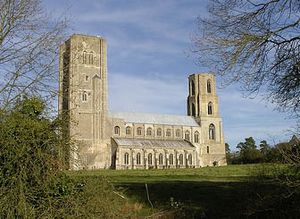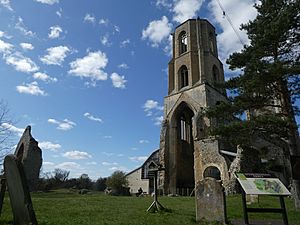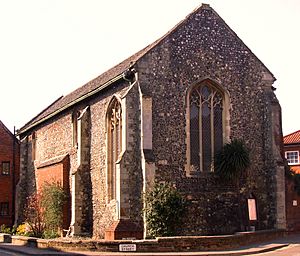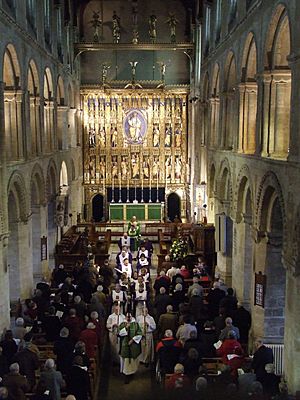Wymondham Abbey facts for kids
Quick facts for kids Wymondham Abbey |
|
|---|---|

View of the south side of the abbey from across the River Tiffey, clearly showing the ruined, octagonal, east tower and the newer square west tower.
|
|
| Location | Wymondham, Norfolk |
| Country | England |
| Denomination | Church of England |
| Previous denomination | Roman Catholic Church |
| Churchmanship | Anglo-Catholic |
| History | |
| Status | Active |
| Architecture | |
| Functional status | Parish Church |
| Administration | |
| Parish | Wymondham |
| Deanery | Deanery of Humbleyard |
| Archdeaconry | Archdeaconry of Norfolk |
| Diocese | Diocese of Norwich |
Wymondham Abbey (say Windum) is a famous church in the town of Wymondham, Norfolk, England. It is part of the Church of England.
This active church offers many different services. These include family-friendly events like Messy Church and services with music. The Abbey is a busy place with lots of groups. There's a youth group called WAY, a choir, and social groups. People are also very interested in the Abbey's long history. About 200 people are official members of the church. Many more attend one of the four Sunday services.
The church is open every day. Around 20,000 visitors come to see it each year. On Sundays, there are services at different times. One service at 9:15 am includes activities for children.
Contents
A Look Back: The Abbey's History
Today, Wymondham Abbey is the main church for the town. But it began its life as a Benedictine priory. This is a type of monastery where monks live and pray.
How the Abbey Started
The monastery was founded in 1107. A man named William d'Aubigny (died 1139) started it. He was a powerful landowner in Norfolk. William was also a butler to King Henry I. His family came from Normandy, a region in France.
William d'Aubigny's monastery was quite small at first. It was home to about twelve Benedictine monks. It was also linked to a larger monastery in St Albans. William's uncle was the head of that monastery. Over time, Wymondham Priory grew bigger and richer. The monks here often argued with the monks from St Albans. In 1448, the Pope agreed to make Wymondham a full Abbey. This meant it was independent.
Building the Church
The monastery church was mostly finished by 1130. It was first dedicated to the Virgin Mary. Later, the name of Saint Thomas Becket was added. This happened after he was murdered in 1170. You can see a modern picture panel in the church. It shows the story of Thomas Becket's life. In 1174, William d'Aubigny's son built a chapel in the town. It was also dedicated to Becket.
The church was originally shaped like a cross. It had a tower in the middle and two towers at the west end. Special stone from Caen in Normandy was brought across the English Channel to build its walls. Around 1376, the central tower was replaced. A tall, eight-sided tower was built instead. This tower held the monks' bells. In 1447, work began on a much taller west tower. This new tower replaced the older ones. It held the bells for the townspeople.
From the very beginning, the church was split into two parts. One part was for the monks. The other part, the nave and north aisle, was for the townspeople. This is still how it works today. Sometimes, this division caused arguments.
Changes Over Time
King Henry VIII closed many monasteries in England. This event is known as the Dissolution of the monasteries. Wymondham Abbey was closed in 1538. The monks were given good pensions. Elisha Ferrers, the last Abbot, became the Vicar of Wymondham.
After the Abbey closed, many of its buildings were pulled down. Their stones were used for other constructions. The eastern part of the church was destroyed. This part had been separated from the main church since about 1385. This means the church today is only about half its original length. Repairs were made to the church after Queen Elizabeth I visited in 1573. You can still see the date and her initials carved on the outside stone.
Special Features of the Abbey
Wymondham Abbey has many interesting features. Its two towers are a landmark you can see from far away. The main part of the church, called the nave, is very old. It was built in the Norman style.
Look up at the roof in the nave. It has beautiful carvings of angels from the 15th century. The roof in the north aisle is also very impressive. The church has high-quality fittings too. These include two organs by James Davis, built in 1783 and 1810.
One of the most striking features is the large, golden altar screen. This screen is called a reredos. It was designed by Sir Ninian Comper. It was dedicated in 1921 as a memorial to soldiers from World War I. The gold finish was completed in 1934.
You can also see early Tudor-style stone seats called sedilia. There's a large candelabrum from the Georgian era. The Royal Arms of George II are also on display. The medieval font, used for baptisms, has a modern golden cover. Look closely at the roof timbers and stone carvings. You'll find angels, musicians, and other figures.
The west tower holds a set of 10 bells. These bells were remade and rehung in 1967. Inside the bell tower, there are six well-preserved hatchments. These are painted boards that were once displayed at funerals.
Important People Buried Here
- William d'Aubigny (died 1139)
- William d'Aubigny, 1st Earl of Arundel
- William d'Aubigny, 2nd Earl of Arundel
- William d'Aubigny, 3rd Earl of Arundel
- William d'Aubigny, 4th Earl of Arundel
- Hugh d'Aubigny, 5th Earl of Arundel
The Abbey Organ
You can find details about the Abbey's organ on the National Pipe Organ Register website.
Past Organists
- Richard Sharp 1793 - 1801
- George Warnes 1828 - 1843
- Reuben Warnes 1844 - 1848
- Mrs Warnes 1849 - 1851
- George Church 1852 - 1857
- Horace Hill 1857 - 1867
- Arthur Glasspoole 1867 - 1880
- James Harcourt 1880 - 1881
- Algernon Wilde 1882 - 1929
- L. Hemingway 1929 - 1930
- Geoffrey Palmer 1930 - 1946
- Winifred Stubbs 1940 - 1955
- N. Charleton-Burdon 1955 - 1956
- Robert Norton 1956 - 1957
- N. Charleton-Burdon 1957 - 1960
- Michael Bryan Hesford 1960 - 1964
- Norman Crowhurst 1964 - 1967
- Maxwell Betts 1967 - 1981
- Ralph Cupper 1981
- Denis Wright 1981 - 1988
- David Baker 1988 - 1995
- Howard Thomas 1995 - 2012
- Robert Goodrich 2012 – present
- Mike Webb 2012–present (Hon.)
Images for kids





